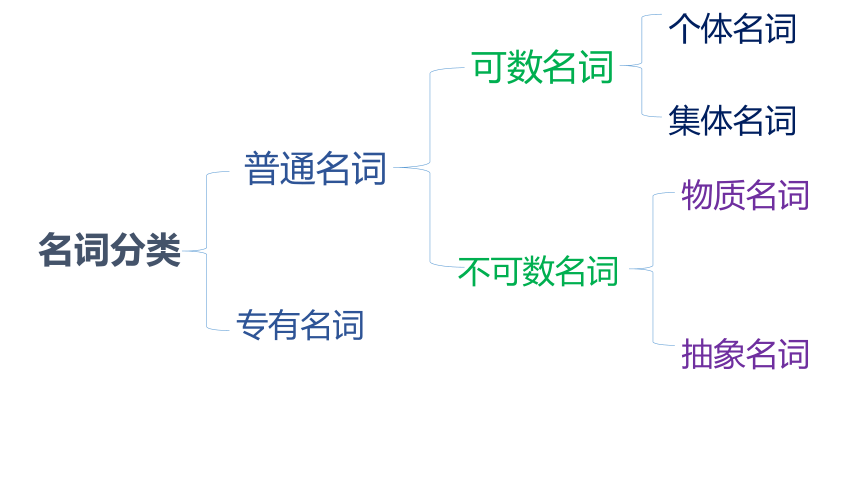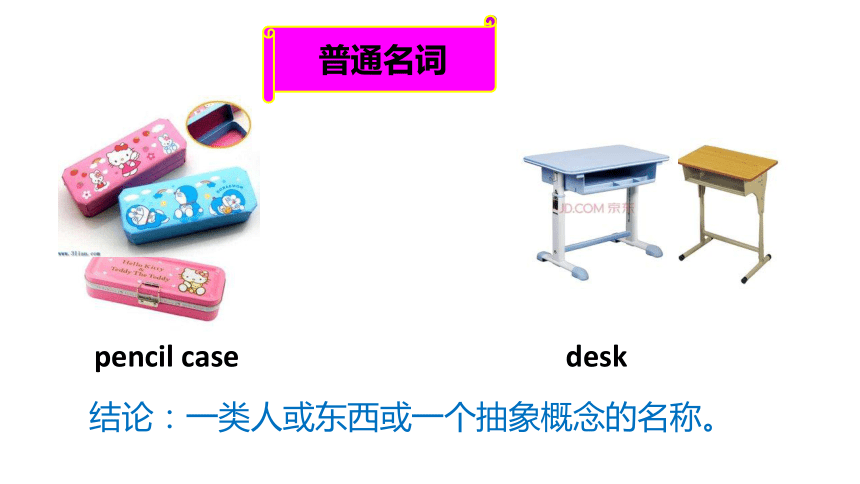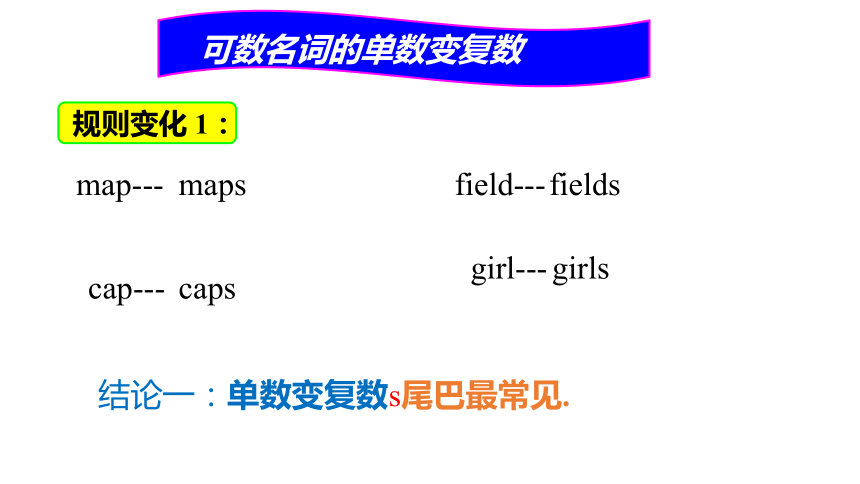全国通用小升初语法专项——名词讲解及练习 课件(共22张PPT)
文档属性
| 名称 | 全国通用小升初语法专项——名词讲解及练习 课件(共22张PPT) |  | |
| 格式 | pptx | ||
| 文件大小 | 5.2MB | ||
| 资源类型 | 教案 | ||
| 版本资源 | 通用版 | ||
| 科目 | 英语 | ||
| 更新时间 | 2021-03-23 19:25:16 | ||
图片预览









文档简介
名词:用来表示________、________、
_______、________和________ 等的一类词。
名词的定义
人
事物
时间
地点
抽象概念
名词分类
普通名词
专有名词
可数名词
不可数名词
个体名词
集体名词
物质名词
抽象名词
专有名词
宋仲基
China
Sanya
结论:1.一个人或事物所特有的名称。
2.首字母大写。
普通名词
pencil case
desk
结论:一类人或东西或一个抽象概念的名称。
可数名词的单数变复数
规则变化 1:
map---
field---
cap---
girl---
maps
caps
fields
girls
结论一:单数变复数s尾巴最常见.
可数名词的单数变复数
规则变化2:
结论2:以x,s, ch,还有 sh 在后面其后也加es.
class--- box---
watch--- dish---
classes
boxes
watches
dishes
规则变化3:
thief- wife- life-
leaf- wolf- shelf-
knife- half- loaf-
结论3:以 f 或 fe 结尾的名词,变为-ves.
口诀:
妻子(wife)持刀(knife)去宰狼,
小偷(thief)吓得发了慌。
躲在架(shelf)后保己(self)命。
半(half)片树叶(leaf)遮目光。
thieves,
wives,
lives,
leaves,
wolves,
shelves
knives,
halves,
loaves(条) ...
规则变化4:
结论5:(1)辅音(字母) 加y要注意,ies替换y
story--- city--- ray---
stories
cities
rays
(2)元音字母 加y 结尾直接加-s.
Negro--- hero--- potato- tomato-
heroes
Negroes
potatoes
tomatoes
结论六:黑人、英雄爱吃土豆、西红柿
2.不规则变化:
goose-
men
women
feet
geese
mice
结论一:改变名词中的元音字母。
man-
woman-
foot-
mouse-
结论:复数形式表示特殊含义
customs(海关) forces(军队)
times(时代) spirits(情绪)
papers(文件报纸) manners(礼貌)
looks(外表) brains(头脑智力)
greens(青菜) ruins(废墟)
结论:不可能只有一样东西!
savings(储蓄)
doings(行为)
findings(调查结果)
以-ing结尾的单词也常常以复数形式出现哦!
结论: 固定搭配,木有办法喽!
有一些名词在固定的短语搭配中也常常以复数的形式出现。
good manners(礼貌)
ladies and gentlemen
see the sights(观光)
复合名词
apple tree
复合名词的复数
结论:将主体名词变为复数形式
looker-on → 旁观者
sister-in-law → 嫂子;弟媳
father-in-law → 岳父
passer-by → 过路人
bride-to-be → 即将做新娘的人
lookers-on
sisters-in-law
passers-by
brides-to-be
fathers-in-law
结论:无主体名词构成的复合名词:
go-between--- 中间人
has-been --- 过时的人、物
good-for-nothing--- 饭桶
grown-up --- 成年人
go-betweens
has-beens
good-for-nothings
grown-ups
最后一个构成部分变为复数形式。
初中单数名词变复数名词口诀:
1.单数变复数s尾巴最常见。
女孩girl→girls
2.特殊情况特殊记,x,s ch,还有sh在后面,其后要加es.
盒子box→boxes 公交车 bus→buses
手表 watch→watches 刷子 brush→brushes
3.辅音加y要注意,ies特换y.
家人family→families
4.黑人英雄爱吃芒果土豆西红柿,其后也加es.
黑人negro+es, 英雄hero+es, 芒果mango+es,
土豆potato+es, 西红柿tomato+es
可数名词单数变复数的口诀
1.一般情况下直接在名词词尾加_______ 。
2.以s, x, sh, ch结尾的名词加 _______ 。
3.以o结尾的无生命的名词后面加______,以o结尾的有生命的名词后面加____ 。
4.以辅音字母加y结尾的名词,变y 为________ ,再加 _______ 。
5.以fe或f结尾的名词,把fe或f变为________ 加 ________ 。
答案:
1.s
2.es
3.s;es
4.i;es
5.v;es
( )1.---What are ______?
---They are crayons.
A.this B.these C.that
( )2.Please pass me_____ .
A.a orange B.an orange C.orange
( )3.There are many _____ .
A.bus B.buss C.buses
( )4.Oh, no! My_____ are dirty.
A.shoe B.shoess C.shoes
( )5.Can you take a_____ for me?
A.photo B.photos C.photoes
答案:
B B C C A
( )6.Ms Smart goes to work on__________ .
A.feet B.foots C.foot
( )7.They are my__________.
A.parents B.parent C.parentes
( )8.How many__________ are there in a week?
A.day B.days C.daies
( )9.---Have a good __________.
. ---Thank you!
A.times B.timing C.time
答案:
C A B C
写出下列单词的复数形式。
bus---- sheep---- photo--- desk----
man--- class---- watch--- teacher---- boy--- baby---- dress--- fox----
leaf--- mouse---- foot--- city----
答案:
buses sheep photos desks
men classes watches teachers
boys babies dresses foxes
leaves mice feet cities
5.妻子持刀去宰狼,小偷吓得发了慌。躲在架后保己命,半片树叶遮目光。
妻子wife→wives 刀knife→knives 狼wolf→wolves 小偷thief→thieves,
架shelf→shelves 命life→lives 半half→halves 树叶leaf→leaves
6.大鹅老鼠齐步走,男男女女呲呲牙。
大鹅goose→geese 老鼠mouse→mice 走(脚)foot→feet
男人man→men 女人woman→women 牙tooth→teeth
7.一个中国人和一个日本人,骑着羊和鹿,去吃水煮鱼。
中国人Chinese→Chinese 日本人Japanese→Japanese
绵羊sheep→sheep 鹿deer→deer 鱼fish→fish
_______、________和________ 等的一类词。
名词的定义
人
事物
时间
地点
抽象概念
名词分类
普通名词
专有名词
可数名词
不可数名词
个体名词
集体名词
物质名词
抽象名词
专有名词
宋仲基
China
Sanya
结论:1.一个人或事物所特有的名称。
2.首字母大写。
普通名词
pencil case
desk
结论:一类人或东西或一个抽象概念的名称。
可数名词的单数变复数
规则变化 1:
map---
field---
cap---
girl---
maps
caps
fields
girls
结论一:单数变复数s尾巴最常见.
可数名词的单数变复数
规则变化2:
结论2:以x,s, ch,还有 sh 在后面其后也加es.
class--- box---
watch--- dish---
classes
boxes
watches
dishes
规则变化3:
thief- wife- life-
leaf- wolf- shelf-
knife- half- loaf-
结论3:以 f 或 fe 结尾的名词,变为-ves.
口诀:
妻子(wife)持刀(knife)去宰狼,
小偷(thief)吓得发了慌。
躲在架(shelf)后保己(self)命。
半(half)片树叶(leaf)遮目光。
thieves,
wives,
lives,
leaves,
wolves,
shelves
knives,
halves,
loaves(条) ...
规则变化4:
结论5:(1)辅音(字母) 加y要注意,ies替换y
story--- city--- ray---
stories
cities
rays
(2)元音字母 加y 结尾直接加-s.
Negro--- hero--- potato- tomato-
heroes
Negroes
potatoes
tomatoes
结论六:黑人、英雄爱吃土豆、西红柿
2.不规则变化:
goose-
men
women
feet
geese
mice
结论一:改变名词中的元音字母。
man-
woman-
foot-
mouse-
结论:复数形式表示特殊含义
customs(海关) forces(军队)
times(时代) spirits(情绪)
papers(文件报纸) manners(礼貌)
looks(外表) brains(头脑智力)
greens(青菜) ruins(废墟)
结论:不可能只有一样东西!
savings(储蓄)
doings(行为)
findings(调查结果)
以-ing结尾的单词也常常以复数形式出现哦!
结论: 固定搭配,木有办法喽!
有一些名词在固定的短语搭配中也常常以复数的形式出现。
good manners(礼貌)
ladies and gentlemen
see the sights(观光)
复合名词
apple tree
复合名词的复数
结论:将主体名词变为复数形式
looker-on → 旁观者
sister-in-law → 嫂子;弟媳
father-in-law → 岳父
passer-by → 过路人
bride-to-be → 即将做新娘的人
lookers-on
sisters-in-law
passers-by
brides-to-be
fathers-in-law
结论:无主体名词构成的复合名词:
go-between--- 中间人
has-been --- 过时的人、物
good-for-nothing--- 饭桶
grown-up --- 成年人
go-betweens
has-beens
good-for-nothings
grown-ups
最后一个构成部分变为复数形式。
初中单数名词变复数名词口诀:
1.单数变复数s尾巴最常见。
女孩girl→girls
2.特殊情况特殊记,x,s ch,还有sh在后面,其后要加es.
盒子box→boxes 公交车 bus→buses
手表 watch→watches 刷子 brush→brushes
3.辅音加y要注意,ies特换y.
家人family→families
4.黑人英雄爱吃芒果土豆西红柿,其后也加es.
黑人negro+es, 英雄hero+es, 芒果mango+es,
土豆potato+es, 西红柿tomato+es
可数名词单数变复数的口诀
1.一般情况下直接在名词词尾加_______ 。
2.以s, x, sh, ch结尾的名词加 _______ 。
3.以o结尾的无生命的名词后面加______,以o结尾的有生命的名词后面加____ 。
4.以辅音字母加y结尾的名词,变y 为________ ,再加 _______ 。
5.以fe或f结尾的名词,把fe或f变为________ 加 ________ 。
答案:
1.s
2.es
3.s;es
4.i;es
5.v;es
( )1.---What are ______?
---They are crayons.
A.this B.these C.that
( )2.Please pass me_____ .
A.a orange B.an orange C.orange
( )3.There are many _____ .
A.bus B.buss C.buses
( )4.Oh, no! My_____ are dirty.
A.shoe B.shoess C.shoes
( )5.Can you take a_____ for me?
A.photo B.photos C.photoes
答案:
B B C C A
( )6.Ms Smart goes to work on__________ .
A.feet B.foots C.foot
( )7.They are my__________.
A.parents B.parent C.parentes
( )8.How many__________ are there in a week?
A.day B.days C.daies
( )9.---Have a good __________.
. ---Thank you!
A.times B.timing C.time
答案:
C A B C
写出下列单词的复数形式。
bus---- sheep---- photo--- desk----
man--- class---- watch--- teacher---- boy--- baby---- dress--- fox----
leaf--- mouse---- foot--- city----
答案:
buses sheep photos desks
men classes watches teachers
boys babies dresses foxes
leaves mice feet cities
5.妻子持刀去宰狼,小偷吓得发了慌。躲在架后保己命,半片树叶遮目光。
妻子wife→wives 刀knife→knives 狼wolf→wolves 小偷thief→thieves,
架shelf→shelves 命life→lives 半half→halves 树叶leaf→leaves
6.大鹅老鼠齐步走,男男女女呲呲牙。
大鹅goose→geese 老鼠mouse→mice 走(脚)foot→feet
男人man→men 女人woman→women 牙tooth→teeth
7.一个中国人和一个日本人,骑着羊和鹿,去吃水煮鱼。
中国人Chinese→Chinese 日本人Japanese→Japanese
绵羊sheep→sheep 鹿deer→deer 鱼fish→fish
